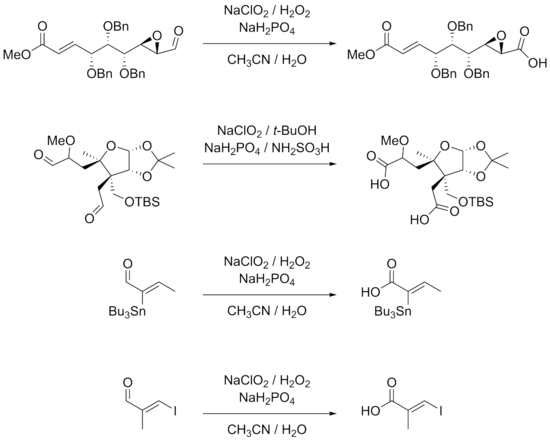The Pinnick oxidation is an organic reaction by which aldehydes can be oxidized into their corresponding carboxylic acids using sodium chlorite (NaClO2) under mild acidic conditions. It was originally developed by Lindgren and Nilsson.The typical reaction conditions used today were developed by G. A. Kraus. H.W. Pinnick later demonstrated that these conditions could be applied to oxidize α,β-unsaturated aldehydes. There exist many different reactions to oxidize aldehydes, but only a few are amenable to a broad range of functional groups. The Pinnick oxidation has proven to be both tolerant of sensitive functionalities and capable of reacting with sterically hindered groups. This reaction is especially useful for oxidizing α,β-unsaturated aldehydes, and another one of its advantages is its relatively low cost.

The proposed reaction mechanism involves chlorous acid as the active oxidant, which is formed under acidic conditions from chlorite.
- ClO2− + H2PO4− ? HClO2 + HPO42−
First, the chlorous acid adds to the aldehyde. Then resulting structure undergoes a pericyclic fragmentation in which the aldehyde hydrogen is transferred to an oxygen on the chlorine, with the chlorine group released as hypochlorous acid (HOCl).

Side reactions and scavengers
The HOCl byproduct, itself a reactive oxidizing agent, can be a problem in several ways.It can destroy the NaClO2 reactant:
- HOCl + 2ClO2− → 2ClO2 + Cl− + OH−
making it unavailable for the desired reaction. It can also cause other undesired side reactions with the organic materials. For example, HOCl can react with double bonds in the organic reactant or product via a halohydrin formation reaction.
To prevent interference from HOCl, a scavenger is usually added to the reaction to consume the HOCl as it is formed. For example, one can take advantage of the propensity of HOCl to undergo this addition reaction by adding a sacrificial alkene-containing chemical to the reaction mixture. This alternate substrate reacts with the HOCl, preventing the HOCl from undergoing reactions that interfere with the Pinnick reaction itself. 2-Methyl-2-butene is often used in this context:

The reaction is highly suited for substrates with many group functionalities. β-aryl-substituted α,β-unsaturated aldehydes works well with the reaction conditions. Triple bonds directly linked to aldehyde groups or in conjugation with other double bonds can also be subjected to the reaction. Hydroxides, epoxides, benzyl ethers, halides including iodides and even stannanes are quite stable in the reaction. The examples of the reactions shown below also show that the stereocenters of the α carbons remain intact while double bonds, especially trisubsituted double bonds do not undergo E/Z–isomerization in the reaction.





